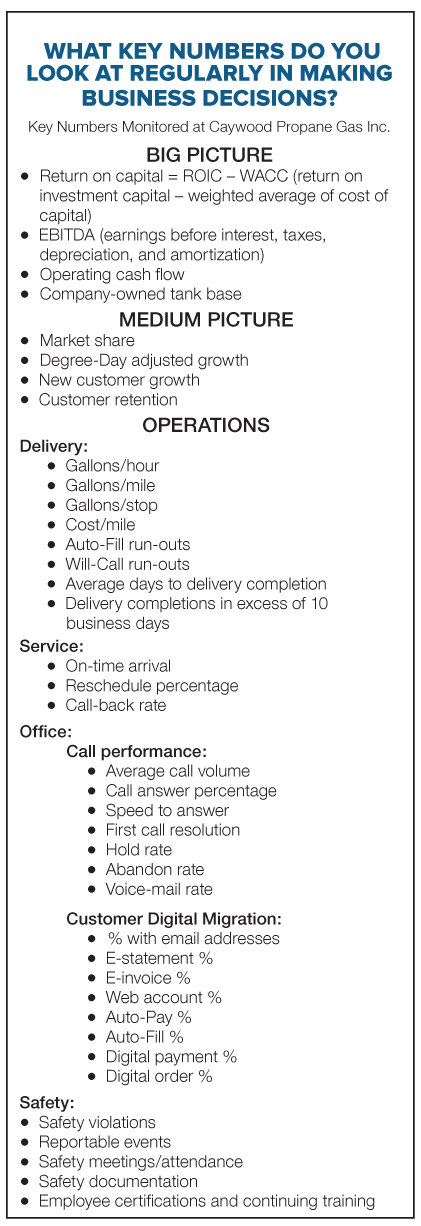Friday, June 12, 2020
What key numbers should retail propane marketers be reviewing? What is the importance of tracking key numbers in running a retail propane business? As discussed in the January issue of BPN, for each marketer, the key numbers will be different depending on the goals and objectives of the business. Recently BPN followed up with Chris Caywood, president of Caywood Propane Gas Inc. (Albion, Coldwater, and Hudson, Mich.), who has updated his list of key numbers he tracks based on the continued refining of goals and objectives for his business. “If it is an important area of the business, we want to measure our progress. We measure and evaluate strategic and business data,” Caywood said. “All of it helps us identify and prioritize opportunities for improvement and make faster decisions to achieve our goals.”
Recently BPN followed up with Chris Caywood, president of Caywood Propane Gas Inc. (Albion, Coldwater, and Hudson, Mich.), who has updated his list of key numbers he tracks based on the continued refining of goals and objectives for his business. “If it is an important area of the business, we want to measure our progress. We measure and evaluate strategic and business data,” Caywood said. “All of it helps us identify and prioritize opportunities for improvement and make faster decisions to achieve our goals.”
Return on capital is a strategic measure for Caywood as well as most businesses. “I can invest in my own business, someone else’s business, or private or public markets,” he said. “In the long run, the stock market will provide a 10% return and it’s both highly liquid and diversified. My own business is neither highly liquid nor diversified, so we need to be compensated for that with a risk premium- which we measure as return on capital.” He calculates return on capital as return on invested capital (ROIC) minus weighted average of cost of capital (WACC).
Comparing ROIC to WACC reveals whether invested capital is yielding an appropriate risk premium. The rule of thumb is that a company creates value if its ROIC exceeds WACC by 2%. Caywood (along with everybody else in the industry) also looks at EBITDA, which stands for earnings before interest, taxes, depreciation, and amortization. Operating cash flow and the company owned-tank base are also key factors.
Business-level metrics include market share. “We calculate our residential share by county as a percentage of the total number of homes using propane as a heat source using Census Bureau data,” Caywood explained. “Degree-day adjusted growth takes into account gallons today versus gallons in a previous period without the noise that can be introduced by weather fluctuations.”
“New customer growth is simple. How many customers do we have now versus in a previous period,” Caywood said. “Retention is based on the percentage of customers that stay with us from period to period.”
In the area of operations, Caywood tracks key numbers that many retail propane marketers track. “Like most, we want to know the gallons we pump per hour, per mile driven, and per stop. We like to know our auto-fill run-outs. It also is very important from a customer service standpoint to take care of a delivery in less than 10 days.”
“Service data is very important to us because we want to improve customer retention,” Caywood added. “So on-time arrival rates for service calls and call-back rates are important metrics.” In the office, telephone call performance is measured using traditional call center metrics like average call volume, answer rates, speed to answer, hold rates, average hold time, abandoned calls, and first call resolution.
“In addition, we use discounts to encourage our customers to interact with us digitally so we can measure our progress using metrics like percentage of customers with email addresses, the percentage of customers who receive e-statements and e-invoices, the percentage of will-call customers who place online or smartphone orders, and percentage of auto-fill customers who use a digital auto-pay feature.”
“Safety also is a very important area that can often be neglected,” Caywood said. “We track any safety violations or reportable events. We document safety meetings and attendance, and we measure and reward employees with safety certificates and continuing training.” — Pat Thornton

Return on capital is a strategic measure for Caywood as well as most businesses. “I can invest in my own business, someone else’s business, or private or public markets,” he said. “In the long run, the stock market will provide a 10% return and it’s both highly liquid and diversified. My own business is neither highly liquid nor diversified, so we need to be compensated for that with a risk premium- which we measure as return on capital.” He calculates return on capital as return on invested capital (ROIC) minus weighted average of cost of capital (WACC).

Comparing ROIC to WACC reveals whether invested capital is yielding an appropriate risk premium. The rule of thumb is that a company creates value if its ROIC exceeds WACC by 2%. Caywood (along with everybody else in the industry) also looks at EBITDA, which stands for earnings before interest, taxes, depreciation, and amortization. Operating cash flow and the company owned-tank base are also key factors.
Business-level metrics include market share. “We calculate our residential share by county as a percentage of the total number of homes using propane as a heat source using Census Bureau data,” Caywood explained. “Degree-day adjusted growth takes into account gallons today versus gallons in a previous period without the noise that can be introduced by weather fluctuations.”
“New customer growth is simple. How many customers do we have now versus in a previous period,” Caywood said. “Retention is based on the percentage of customers that stay with us from period to period.”
In the area of operations, Caywood tracks key numbers that many retail propane marketers track. “Like most, we want to know the gallons we pump per hour, per mile driven, and per stop. We like to know our auto-fill run-outs. It also is very important from a customer service standpoint to take care of a delivery in less than 10 days.”
“Service data is very important to us because we want to improve customer retention,” Caywood added. “So on-time arrival rates for service calls and call-back rates are important metrics.” In the office, telephone call performance is measured using traditional call center metrics like average call volume, answer rates, speed to answer, hold rates, average hold time, abandoned calls, and first call resolution.
“In addition, we use discounts to encourage our customers to interact with us digitally so we can measure our progress using metrics like percentage of customers with email addresses, the percentage of customers who receive e-statements and e-invoices, the percentage of will-call customers who place online or smartphone orders, and percentage of auto-fill customers who use a digital auto-pay feature.”
“Safety also is a very important area that can often be neglected,” Caywood said. “We track any safety violations or reportable events. We document safety meetings and attendance, and we measure and reward employees with safety certificates and continuing training.” — Pat Thornton


